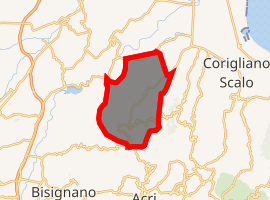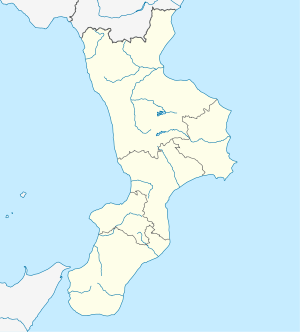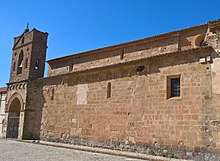San Demetrio Corone
San Demetrio Corone(Arbëreshë: Shën Mitri) is a town ,with an altitude of 521 meters ,3,387 inhabitants, and municipality in the Calabria region ( Italy ) . The town is among the most important cultural centers of the Albanian communities in Italy and preserves the Albanian language, the Byzantine rite, customs, culture and ethnic identity of its origin.It is home to the Collegio of Sant'Adriano,a boarding school which produced many patriots and theorists/revolutionaries in the Italian Independence wars and important religious and cultural organism for the conservation of the oriental rite and of the albanian traditions. It is part of the district of the Italo-Albanian Church of the Eparchy of Lungro.
San Demetrio Corone | |
|---|---|
| Comune di San Demetrio Corone and Bashkia e Shën Mitrit | |
 | |
Coat of arms | |
Location of San Demetrio Corone 
| |
 San Demetrio Corone Location of San Demetrio Corone in Italy  San Demetrio Corone San Demetrio Corone (Calabria) | |
| Coordinates: 39°34′N 16°22′E | |
| Country | Italy |
| Region | Calabria |
| Province | Cosenza (CS) |
| Frazioni | Macchia Albanese, Guriza, Sofferetti, Sant'Agata, San Nicola, Piedigallo |
| Government | |
| • Mayor | Salvatore Lamirata |
| Area | |
| • Total | 61.87 km2 (23.89 sq mi) |
| Elevation | 521 m (1,709 ft) |
| Population (31 December 2010)[2] | |
| • Total | 3,693 |
| • Density | 60/km2 (150/sq mi) |
| Demonym(s) | Sandemetresi (in arbëreshë Shënmitrotë) |
| Time zone | UTC+1 (CET) |
| • Summer (DST) | UTC+2 (CEST) |
| Postal code | 87069 |
| Dialing code | 0984 |
| Patron saint | St. Demetrius Megalomartyr |
| Saint day | 26 October |
| Website | Official website |
In the Macchia Albanese hamlet, located at 418 meters above sea level, Girolamo De Rada was born, supreme vate arbëresh, father of modern Albanian literature.
For years the music, singing and new sounds of the Albanians of Italy have been grouped here in "The Festival of the Arbëreshe Song".
Geography
The village is surrounded by lush vegetation and overlooks the Piana (plains) di Sibari. The topographic altitudes oscillate, for the higher southern area, between 500 and 800 meters above sea level and between 400 and 40 meters for the northern portion. The entire territory is characterized by a rather developed and complex hydrographic network. Almost all of them are tributaries of the Crati river.
In the upper part the dominant vegetation is represented by chestnut groves. The northern area, on the other hand, sloping down towards the Piana di Sibari, has a morphology with the presence of plateaus and terraces. The territory, of a total of 7,500 hectares, has a vision of the Pollino National Park and the Ionian Sea It is bordered by Acri, Corigliano-Rossano, San Cosmo Albanese, Vaccarizzo Albanese, Santa Sofia d'Epiro, Tarsia and Terranova da Sibari.
History
San Demetrio Corone was built in the late 15th century by exiles Albanians forced into exile by the Turkish-Muslim. Its founders arrived there from Albania in 1471, later others Albanians from the second diaspora, many from the albanofone areas in the Morea , in particular by Corone following Duke Teodoro Lopez.
The Albanian exiles built the inhabited center near the ancient oratory of Sant'Adriano, where in 10th century Nilus the Younger he had taken refuge to pray, living in a cave, creating a local Basilian monastic life. However, the area was inhabited in a previous period, always dating back to settlements of oriental monks (VII century). The first settlement was known in Latin as Situ Sancti Dimitri , even if its inhabitants have always called it katundi i Shën Mitrit . Evidence of the fact that a small monastery existed before the arrival of the Albanians is given by the Capitulations of November 3 1471, when the Archimandrite abbot Paolo Greco went to the notary De Angelis to draw up a deed which registered the commitment to welcome the Albanian refugees following the Duke Teodoro Lopez in the hamlet of San Demetrio, with the right to cultivate the land.
In 1524 there was a new Albanian immigration following the war that Charles V waged against the Turks: the Albanians of Corone, city of Morea, today Peloponnese, were welcomed by the Emperor in the Kingdom of Naples and distributed in the various villages founded by their predecessors, including San Demetrius.
After the constitution of the Kingdom of Italy the name "Corone", in memory of the Albanian diaspora, in particular the second one, was added to the municipality (1863).
San Demetrio Corone is the seat of the Italo-Albanian College of Sant'Adriano: originally called Collegio Corsini, it was established by Pope Clement XII in 1732 in San Benedetto Ullano, in order to prepare the Italo-Albanian clergy to the preservation of the Byzantine rite - Greek. It was then transferred to San Demetrio Corone in 1794, following the request of Bishop Francesco Bugliari. Since 1794 the history of the area has been deeply linked to that of the College, founded by king Ferdinand IV in place of the suppressed monastery. It became an important cultural organism of the Albanians of Italy, as well as the first cultural training institute in Calabria, from whose walls luminous figures of the Italian Risorgimento emerged such as Agesilao Milano (1830-1856 ) and Domenico Mauro (1812-1873), and writers and jurists such as Cesare Marini (1792-1865) and Girolamo De Rada (1814-1903).
Monuments and places of interest
Religious architectures
- Basilian church of Sant'Adriano, founded by Nilus the Younger in 955, later the Italo-Albanian College of Sant'Adriano (1794) ,is an example of early Norman-Byzantine architecture and contains some mosaics and other medieval artifacts.
 Norman-Byzantine Church of Sant'Adriano
Norman-Byzantine Church of Sant'Adriano
References
- "Superficie di Comuni Province e Regioni italiane al 9 ottobre 2011". Istat. Retrieved 16 March 2019.
- Population data from ISTAT